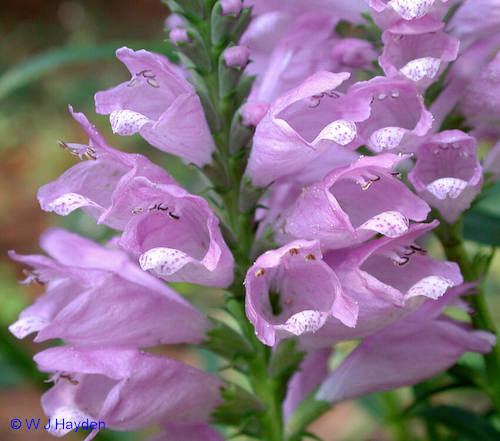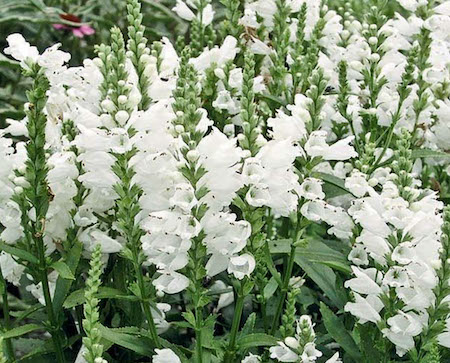The Virtues of the Not-So-Obedient Obedient Plant
by Jo Anna Natale, Fairfax Master Gardener

Obedient plant flower
Beginning in late summer, when my garden has suffered the season’s extremes, an intrepid flower unfurls everywhere, if I am not careful.
Known commonly as obedient plant, Physostegia virginiana is anything but obedient, in terms of staying put in the perennial bed. In fact, if this kin to the mint family were not so welcome in the last jungly days of summer, when many other bloomers have said “to heck with it” — I might consider it a thug. But instead, I’m perennially thankful for its perky, purple blooms, which persist sometimes even until November.
Land-grabber that it is, obedient plant earns its nickname another way: Its individual flowers will bend in whatever direction their arranger dictates. But besides being plucky and flexibly-flowered, obedient plant gives the gardener plenty else to love.

My obedient plant
Depending on the variety, it produces lavender, pink or white flowers reminiscent of snapdragons (hence obedient plant’s other common name, false dragonhead). Its blooms might begin in Northern Virginia in late August, but their show continues right through the fall, with flowers opening progressively up sturdy spires. The plants, which feature serrated leaves, can grow to 4 feet high in clumps that stretch wide if left unchecked, especially in sunny, moist locations. Perfection, however, isn’t required. This native thrives in part-shade, too, growing in Zones 4 through 10a. And although it loves moisture and is a natural in a rain garden, it tolerates dry conditions and poor drainage, as well. Once cut, its flowers are lovely in fall bouquets, providing a pointy contrast to the ubiquitous, round faces of asters and mums.
Several forms of wildlife are as happy to see it emerge as I am. With obedient plant, bees, hummingbirds and butterflies can continue feasting long after other nectars on their summer buffet have dried up. Luckily, however, rabbits and deer could care less for the taste of these blooms.
Sometimes, aphids can attack, as can blackspot fungal disease. The plant can also get gangly and require staking. Otherwise, obedient plant’s main drawback, as far as the gardener is concerned, is its ambitious habit. This can be a plus if you are looking for a greedy, tall groundcover to crowd out weeds. But if you want to encourage other plants in your garden, you’d be wise to pull obedient plant’s unwanted growth in spring, before its white rhizomes shoot into unclaimed soil.

Obedient Plant ‘Miss Manners’
To add it to your garden, plant seeds in late fall — or in spring after subjecting them to some cold time in the fridge. Plants and divisions can go in either in spring or fall. While there are many varieties, check out Physostegia virginiana ‘Variegata’ for lavender flowers; Physostegia virginiana ‘Bouquet Rose’ for pink flowers; and Physostegia virginiana ‘Miss Manners’ for white flowers.
I added obedient plant to my own garden 15 years ago and consider it a reliable friend, albeit one with a somewhat overbearing nature. But as is the case with most reliable friends, obedient plant is worth the effort, even if it means dealing with a character flaw or two.
Resources
• Creating Inviting Habitats, Mary Free, Virginia Cooperative Extension, Publication HORT-59NP
• Physostegia virginiana, North Carolina Extension Gardener Plant Toolbox
• Physostegia virginiana, United States Department of Agriculture, National Resources Conservation
Service
• Physostegia virginiana, University of Florida Cooperative Extension Service, Fact Sheet FPS-477